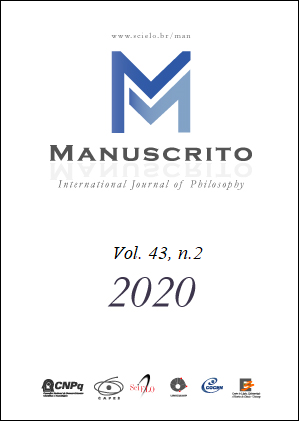Resumen
Los pensamientos demostrativos se distinguen por el hecho de que sus contenidos se determinan relacionalmente, a través de la percepción, más que descriptivamente. Por tanto, una tarea fundamental de una teoría del pensamiento demostrativo es dilucidar cómo los hechos sobre la percepción visual pueden explicar cómo estos pensamientos llegan a tener los contenidos que tienen. El propósito de este artículo es investigar cómo la psicología cognitiva puede ayudarnos a resolver esta cuestión metasemántica, a través de modelos empíricos de procesamiento visual. Aunque existe una disputa entre los modelos atencionales y no atencionales sobre el mejor mecanismo metasemántico para el pensamiento demostrativo, en este artículo argumentaré a favor de un modelo híbrido, que combina ambos tipos de procesos. En esta imagen, los mecanismos de atención y no atención no son mutuamente excluyentes, y cada uno juega un papel específico en la determinación del contenido singular de los pensamientos demostrativos.
Citas
Awh, E., Pashler, H. “Evidence for Split Attentional Foci.” Journal of Experimental Psychology: Human Perception and Performance, 26 (2), pp. 834–846, 2000.
Bach, K. Thought and Reference. Oxford: Oxford University Press, 1987.
Block, N. “On a Confusion About the Function of Consciousness.” Behavioral and Brain Sciences, 18, pp. 227– 47, 1995.
Burge, T. “Belief De Re.” The Journal of Philosophy, 74 (6), pp. 338-362, 1977.
_____. The Origins of Objectivity. Oxford: Oxford University Press, 2010. Campbell, J. “Sense, Reference and Selective Attention.” Proceedings of the Aristotelian Society, 71, pp. 55–98, 1997.
_____. Reference and Consciousness. Oxford: Oxford University Press, 2002.
Cavanagh, P., Alvarez, G.A. "Tracking multiple targets with multifocal attention.” Trends in Cognitive Science, 9(7), pp. 349-354, 2005.
De Carvalho, F.N. Demonstrative Thought: A Pragmatic View. Berlin, Boston: De Gruyter, 2016.
_____. Newen, A. “A Role for the Prefrontal Cortex in Supporting Singular Demonstrative Reference.” Journal of Consciousness Studies, 26 (11-12), pp. 133-156, 2019.
Dedrick, D., Trick, L. Computation, Cognition, and Pylyshyn. Cambridge, MA: MIT Press, 2009.
Driver, J, et al. “Segmentation, Attention and Phenomenal Visual Objects.” Cognition, 80 (1-2), pp. 61–95, 2001.
Evans, G. The Varieties of Reference. Oxford: Oxford University Press, 1982.
Fodor, J.A. The Language of Thought. Cambridge, MA: Harvard University Press, 1975.
Hatfield. G. Perception and Cognition: Essays in the Philosophy of Psychology. Oxford: Oxford University Press, 2009.
Kahneman, D., et al. “The Reviewing of Object Files: Obect-specific Integration of Information.” Cognitive Psychology, 24 (2), pp. 175–219, 1992.
Lamme, V. “Why Visual Attention and Awareness Are Different.” Trends in Cognitive Science, 7(1), pp. 12–18, 2003.
Levine, J. “Demonstrative Thought.” Mind and Language, 25 (2), pp. 169–195, 2010. Peacocke, C. “Demonstrative Thought and Psychological Explanation.” Synthese, 49(2), pp. 187-217, 1981.
Posner, M., et al. “Attention and the detection of signals.” Journal of Experimental Psychology: General, 109, pp. 160- 174, 1980.
Pylyshyn, Z. “Is Vision Continuous with Cognition? The Case for Cognitive Impenetrability of Visual Perception.” Behavioral and Brain Sciences, 22(3), pp. 341–365, 1999.
_____ .“Visual Indexes, Preconceptual Objects, and Situated Vision.” Cognition, 80, pp. 127–158, 2001.
_____. Things and Places: How the Mind Connects With the World. Cambridge, MA: MIT Press, 2007.
Quine, W.V.O. From Stimulus to Science. Cambridge, MA: Harvard University Press, 1995.
Raftopoulos, A. “Reference, Perception, and Attention.” Philosophical Studies, 144 (3), pp. 339–360, 2009a.
_____. Cognition and Perception: How Do Psychology and Neural Science Inform Philosophy? Cambridge, MA: MIT Press, 2009b.
_____. & Müller, V.C. “Nonconceptual Demonstrative Reference.” Philosophy and Phenomenological Research, 72(2), pp. 251–285, 2006.
Rensink, R.A. “The Dynamic Representation of Scenes.” Visual Cognition, 7 (1-3), pp. 17–42, 2000.
Scholl, B. “What Have We Learned About Attention from Multiple Object Tracking (and Vice Versa)?” In D. Dedrick and L. Trick (eds.) (2009), pp. 49–78.
Smith, A. D. The Problem of Perception. Cambridge: Harvard University Press, 2002.
Stazicker, J. "Attention, Visual Consciousness and Indeterminacy.” Mind & Language, 26(2), pp. 156-184, 2011.
Strawson, P.F. Individuals: An Essay in Descriptive Metaphysics. London: Routledge, 1959.
Treisman, A., Gelade, G. “A Feature-integration Theory of Attention.” Cognitive Psychology, 12 (1), pp. 97–136, 1980.
Yantis, S. “Objects, Attention and Perceptual Experience.” In: R.D. Wright (ed.) (1998), pp. 187–214.
_____. & Jonides, J. “Abrupt visual onsets and selective attention: evidence from visual search.” Journal of Experimental Psychology: Human Perception and Performance, 10(5), pp. 601-21, 1984.
_____. & Hillstrom, A.P. “Stimulus-driven Attentional Capture: Evidence from Equiluminant Visual Objects.” Journal of Experimental Psychology. Human Perception and Performance, 20 (1), pp. 95–107, 1994.
Wright, R.D. Visual Attention. Oxford: Oxford University Press, 1998.
Wu, W. “What Is Conscious Attention?” Philosophy and Phenomenological Research, 82(1), pp. 93-120, 2011.


